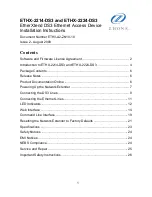
AirLive WN-151ARM User’s Manual
110
Cable and Connector Loss
During wireless design and deployment, it is important to factor in the cable and connector loss. Cable and
connector loss will reduce the output power and receiver sensitivity of the radio at connector end. The longer
the cable length is, the more the cable loss. Cable loss should be subtracted from the total output power
during distance calculation. For example, if the cable and connector loss is 3dBm and the output power is
20dBm; the output power at the cable end is only 17dBm.
Client
Client means a network device or utility that receives service from host or server. A client device means end
user device such as wireless cards or wireless CPE.
CPE Devices
CPE stands for Customer Premises Equipment. A CPE is a device installed on the end user's side to receive
network services. For example, on an ADSL network, the ADSL modem/router on the subscriber's home is
the CPE device. Wireless CPE means a complete Wireless (usually an AP with built-in Antenna) that receives
wireless broadband access from the WISP. The opposite of CPE is CO.
CTS
Clear To Send. A signal sent by a device to indicate that it is ready to receive data.
DDNS
Dynamic Domain Name System. An algorithm that allows the use of dynamic IP address for hosting Internet
Server. A DDNS service provides each user account with a domain name. A router with DDNS capability has
a built-in DDNS client that updates the IP address information to DDNS service provider whenever there is a
change. Therefore, users can build website or other Internet servers even if they don't have fixed IP
connection.
DHCP
Dynamic Hosting Configuration Protocol. A protocol that enables a server to dynamically assign IP addresses.
When DHCP is used, whenever a computer logs onto the network, it automatically gets an IP address
assigned to it by DHCP server. A DHCP server can either be a designated PC on the network or another
network device, such as a router.










































